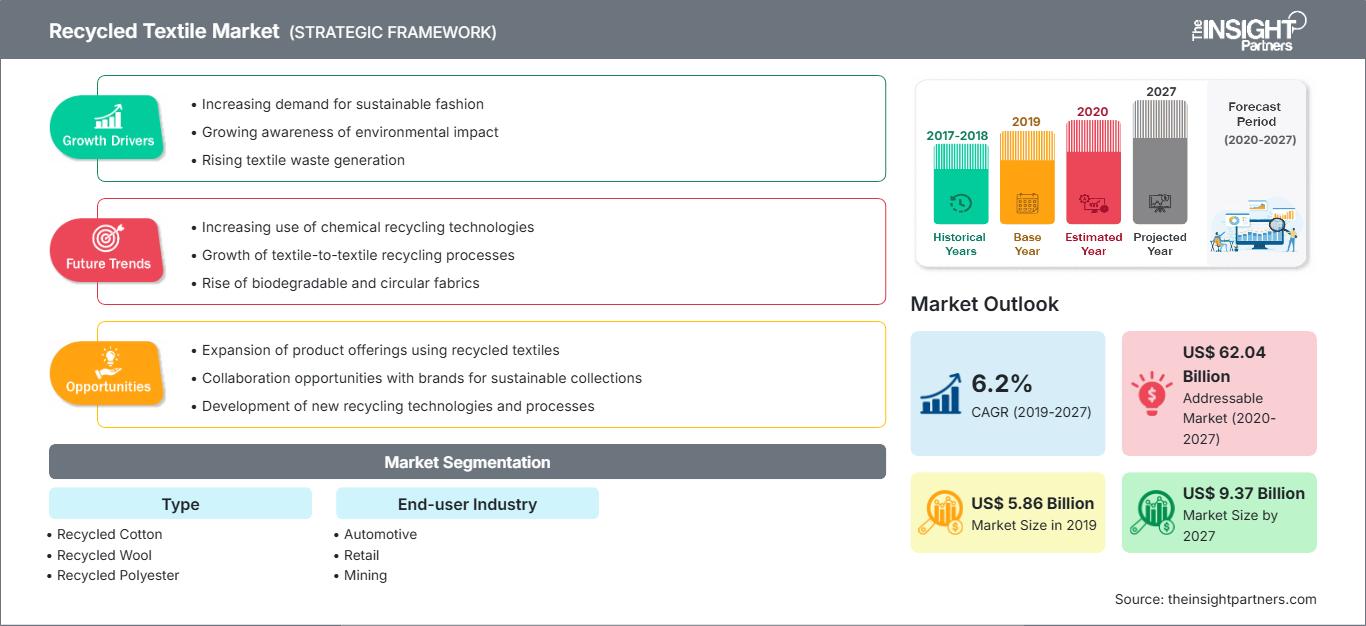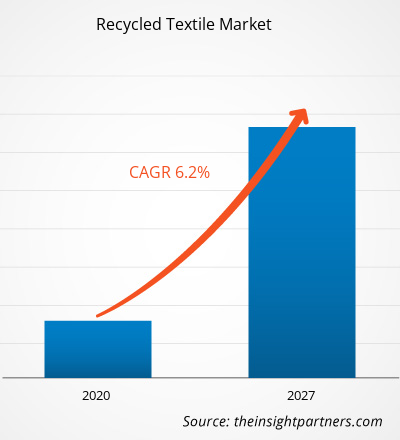Der Markt für recycelte Textilien wurde im Jahr 2019 auf 5.855,39 Millionen US-Dollar geschätzt und soll bis 2027 voraussichtlich 9.365,04 Millionen US-Dollar erreichen; von 2020 bis 2027 wird ein durchschnittliches jährliches Wachstum von 6,2 % erwartet.
Recycelte Textilien sind alte Kleidung oder andere ungenutzte Textilien, die zur Wiederverwendung oder Materialrückgewinnung zurückgewonnen werden können. In den letzten Jahren gab es weltweit zunehmende Bedenken hinsichtlich der Entsorgung von Textilabfällen, die sich negativ auf die Umwelt auswirken können. Die Nachfrage nach recycelten Textilien steigt weltweit an, da die Nachfrage aus verschiedenen Endverbrauchsbranchen stark ansteigt, darunter die Bekleidungs-, Textil-, Automobil- und andere Industriezweige. Hersteller recyceln die gebrauchten Textilien zu besseren Produkten, die in verschiedenen Endverbrauchsbranchen eingesetzt werden können, und haben hierfür verschiedene Technologien übernommen. Das Recycling von Ressourcen kann hauptsächlich mithilfe thermischer, mechanischer und chemischer Verfahren erfolgen.
Europa hat sich aufgrund zunehmender staatlicher Initiativen in der Region zu einem bedeutenden Markt für recycelte Textilien entwickelt. Darüber hinaus bietet die wachsende Nachfrage der Automobilindustrie nach recycelten Textilprodukten eine lukrative Chance für die Akteure des Marktes für recycelte Textilien. Die steigende Kaufkraft in Verbindung mit einem veränderten Lebensstil ist einer der wichtigsten Wachstumsfaktoren für den Textilmarkt in Europa. In Europa werden fast 15 % der von Verbrauchern getragenen Kleidung recycelt, während über 75 % der gebrauchten Kleidung von den Herstellern für industrielle Zwecke recycelt werden. Die Nachfrage nach recycelten Textilien ist in Europa in den letzten Jahren am schnellsten gestiegen. Die Hersteller von recycelten Textilien konzentrieren sich auf Länder wie Deutschland, Großbritannien usw., was zu einer enormen Nachfrage nach recycelten Textilien in Europa geführt hat. Auch die zunehmende Konzentration der Verbraucher auf eine Kreislaufwirtschaft für Textilien dürfte das Marktwachstum in der Region zusätzlich ankurbeln.
Die USA, Brasilien, Indien, Russland, Südafrika, Mexiko, Spanien und Großbritannien gehören im Hinblick auf die bestätigten Fälle und gemeldeten Todesfälle im August 2020 zu den am stärksten betroffenen Ländern. COVID-19 hat aufgrund von Lockdowns, Reiseverboten und Geschäftsschließungen die Wirtschaft und Industrie in zahlreichen Ländern beeinträchtigt. Die globale Chemie- und Werkstoffindustrie ist einer der wichtigsten Wirtschaftszweige, die aufgrund des COVID-19-Ausbruchs unter schwerwiegenden Störungen wie Lieferkettenunterbrechungen und Produktionsunterbrechungen leidet. China beispielsweise ist das globale Zentrum der Produktion und der größte Rohstofflieferant für verschiedene Branchen. Die Schließung verschiedener Werke und Fabriken in China und führenden Regionen wie dem Asien-Pazifik-Raum und Europa beeinträchtigt die globalen Lieferketten und wirkt sich negativ auf die Produktion, die Lieferzeiten und den Verkauf verschiedener Waren aus. All diese Faktoren haben erhebliche Auswirkungen auf den globalen Markt für recycelte Textilien.
Passen Sie diesen Bericht Ihren Anforderungen an
Sie erhalten kostenlos Anpassungen an jedem Bericht, einschließlich Teilen dieses Berichts oder einer Analyse auf Länderebene, eines Excel-Datenpakets sowie tolle Angebote und Rabatte für Start-ups und Universitäten.
Markt für recycelte Textilien: Strategische Einblicke

-
Holen Sie sich die wichtigsten Markttrends aus diesem Bericht.Dieses KOSTENLOSE Beispiel umfasst Datenanalysen, die von Markttrends bis hin zu Schätzungen und Prognosen reichen.
Die Textilherstellung gilt als einer der chemieintensiven Prozesse, bei denen im Laufe des Betriebs große Mengen Textilabfall entstehen. Der Textilabfall lässt sich in zwei Gruppen unterteilen: vor dem Gebrauch entstandene Textilabfälle und nach dem Gebrauch entstandene Textilabfälle. Die steigende Menge an Textilabfällen belastet die Umwelt und erschwert die effektive Entsorgung oder Verbrennung auf bestehenden Mülldeponien. Schätzungen zufolge gelten etwa 10–20 % aller ungenutzten Textilprodukte als Abfall. So fielen der US-Umweltschutzbehörde EPA zufolge im Jahr 2015 insgesamt 15,75 Millionen Tonnen Textilien als Siedlungsabfall an, von denen 19 % verbrannt und 65 % auf Mülldeponien landeten. Darüber hinaus legt ein Bericht der US-Umweltschutzbehörde nahe, dass die Produktion und Entsorgung von Textilien zu Treibhausgasemissionen führt. Darüber hinaus werden beim Verbrennungsprozess organische Substanzen wie Schwermetalle, Dioxine, säurehaltige Gase und Staubpartikel freigesetzt, die als schädlich für Mensch und Umwelt gelten. Auch die Entsorgung der Restasche ist zu einem ernsthaften Problem geworden, da sie eine hohe Konzentration giftiger Stoffe enthält. Daher ist es unerlässlich, Textilabfälle durch Wiederverwendung oder Recycling effektiv zu entsorgen, um die Umweltverträglichkeit zu fördern. Unter solchen Umständen gilt das Recycling von Textilabfällen als praktikable Alternative, die dazu beiträgt, die Belastung natürlicher Ressourcen zu reduzieren, den Bedarf an Deponieraum zu minimieren und Energie zu sparen. Darüber hinaus zielen die strengen staatlichen Gesetze zur effektiven Entsorgung von Textilabfällen potenziell darauf ab, die Nutzung des Textilrecyclings als nachhaltige Alternative zur Lösung des drohenden Abfallproblems zu fördern.
Typeneinblicke
Basierend auf den Typen ist der Markt für recycelte Textilien in recycelte Baumwolle, recycelte Wolle, recyceltes Polyester, recyceltes Nylon und andere unterteilt. Das Segment recyceltes Nylon wird im Prognosezeitraum 2019–2027 voraussichtlich das schnellste Wachstum verzeichnen. Recyceltes Nylon wird aus Industriekunststoffen, Faserabfällen, Webereiabfällen und gebrauchten Fischernetzen hergestellt. Diese werden zu neuem Nylon regeneriert, das die gleiche Qualität wie Neunylon aufweist. Auch Nylontaschen, Nylonstoffe und Nylonteppiche werden für die weitere Verwendung zu recyceltem Nylon verarbeitet. Ein großer Teil des recycelten Nylons stammt aus Fischernetzen. Es ist eine hervorragende Lösung, um Meeresmüll zu vermeiden. Nylonrecycling ist im Vergleich zu Nylon ein teurer Prozess, bietet aber viele Umweltvorteile. Durch Recycling von Nylon können Abfälle vermieden und die Treibhausgasemissionen aus der Herstellung reduziert werden. Die Abhängigkeit von Erdöl als Rohstoffquelle wird verringert. Die Verwendung von recyceltem Nylon trägt zudem dazu bei, neue Recyclingströme für nicht mehr verwendete Nylonprodukte zu fördern. Die meisten mechanisch recycelten Materialien werden bei hohen Temperaturen geschmolzen, wodurch Schadstoffe zerstört und die Materialien wiederverwendbar werden. Nylon schmilzt beim Recycling bei niedrigen Temperaturen und hinterlässt die Schadstoffe. Daher muss Nylon vor dem Recycling sorgfältig gereinigt werden.
Brancheneinblicke für Endverbraucher
Basierend auf der Endverbraucherbranche ist der Recyclingmarkt in die Branchen Automobil, Einzelhandel, Bergbau und Sonstige unterteilt. Das Automobilsegment wird im Prognosezeitraum 2019–2027 voraussichtlich das schnellste Wachstum verzeichnen. Recycelte Textilien werden in der Automobilindustrie verwendet und leisten einen großen Beitrag zur Produktion von Autokomponenten. Die Verwendung recycelter Textilien in Automobilanwendungen umfasst sichtbare Komponenten wie Bodenbeläge, Polsterungen, Sicherheitsgurte und für Betrachter nicht sichtbare recycelte Textilien wie Schläuche und Bänder, Reifencord, Airbagkomponenten und Fasern. Recycelte Textilien werden in der Automobilindustrie aufgrund ihrer Zugfestigkeit, Abriebfestigkeit, Luftdurchlässigkeit, Druckfestigkeit, Elastizität, Reinigungsfreundlichkeit, Flammwidrigkeit und Beständigkeit gegenüber dynamischen klimatischen Bedingungen verwendet. Recycelte Baumwolle wird als Sitzfüllung oder Fahrzeugisolierung verwendet.
Anandi Enterprises, Chindi, Khaloom Textile India Pvt. Ltd., Kishco Group und andere sind die wichtigsten Akteure auf dem globalen Markt für recycelte Textilien. Diese Unternehmen entwickeln neue Produkte und setzen auf Fusions- und Übernahmestrategien, um ihren Kundenstamm zu erweitern und weltweit bedeutende Marktanteile zu gewinnen. Dies ermöglicht es den Akteuren wiederum, ihren Markennamen weltweit zu behaupten.
Markt für recycelte Textilien
Markt für recycelte TextilienDie Analysten von The Insight Partners haben die regionalen Trends und Faktoren, die den Markt für Recyclingtextilien im Prognosezeitraum beeinflussen, ausführlich erläutert. In diesem Abschnitt werden auch die Marktsegmente und die geografische Lage in Nordamerika, Europa, dem asiatisch-pazifischen Raum, dem Nahen Osten und Afrika sowie Süd- und Mittelamerika erörtert.Umfang des Marktberichts über recycelte Textilien
| Berichtsattribut | Einzelheiten |
|---|---|
| Marktgröße in 2019 | US$ 5.86 Billion |
| Marktgröße nach 2027 | US$ 9.37 Billion |
| Globale CAGR (2019 - 2027) | 6.2% |
| Historische Daten | 2017-2018 |
| Prognosezeitraum | 2020-2027 |
| Abgedeckte Segmente |
By Typ
|
| Abgedeckte Regionen und Länder |
Nordamerika
|
| Marktführer und wichtige Unternehmensprofile |
|
Dichte der Akteure auf dem Markt für recycelte Textilien: Verständnis ihrer Auswirkungen auf die Geschäftsdynamik
Der Markt für recycelte Textilien wächst rasant. Die steigende Nachfrage der Endverbraucher ist auf Faktoren wie veränderte Verbraucherpräferenzen, technologische Fortschritte und ein stärkeres Bewusstsein für die Produktvorteile zurückzuführen. Mit der steigenden Nachfrage erweitern Unternehmen ihr Angebot, entwickeln Innovationen, um den Bedürfnissen der Verbraucher gerecht zu werden, und nutzen neue Trends, was das Marktwachstum weiter ankurbelt.

- Holen Sie sich die Markt für recycelte Textilien Übersicht der wichtigsten Akteure
- Fortschreitende Branchentrends auf dem globalen Markt für recycelte Textilien helfen den Akteuren bei der Entwicklung effektiver langfristiger Strategien
- Geschäftswachstumsstrategien in entwickelten und sich entwickelnden Märkten
- Quantitative Analyse des globalen Marktes für recycelte Textilien von 2017 bis 2027
- Schätzung der globalen Nachfrage nach recycelten Textilien in verschiedenen Branchen
- PEST-Analyse zur Veranschaulichung der Wirksamkeit von in der Branche tätigen Käufern und Lieferanten zur Vorhersage des Marktwachstums
- Jüngste Entwicklungen zum Verständnis des Wettbewerbsmarktszenarios und der globalen Nachfrage nach recycelten Textilien
- Markttrends und -aussichten in Verbindung mit Faktoren, die das Wachstum des globalen Marktes für recycelte Textilien fördern und hemmen
- Entscheidungsprozess durch das Verständnis von Strategien, die das kommerzielle Interesse im Hinblick auf das Wachstum des globalen Marktes für recycelte Textilien untermauern
- Globale Marktgröße für recycelte Textilien an verschiedenen Marktknotenpunkten.
- Detaillierter Überblick und Segmentierung des globalen Marktes für recycelte Textilien sowie dessen Dynamik in der Branche
- Globale Marktgröße für recycelte Textilien in verschiedenen Regionen mit vielversprechendem Wachstum Chancen
Globaler Markt für recycelte Textilien, nach Typ
- Recycelte Baumwolle
- Recycelte Wolle
- Recyceltes Polyester
- Recyceltes Nylon
- Andere
Globaler Markt für recycelte Textilien, nach Endbenutzer Industrie
- Automobilindustrie
- Einzelhandel
- Bergbau
- Andere
Unternehmensprofile
- Anandi Enterprises
- Chindi
- Khaloom Textile India Pvt. Ltd.
- Kishco Group
- Usha Yarns Limited
- Hyosung Corporation
- Leigh Fibres Inc.
- Martex Fiber Southern Corporation
- Renewcell AB
- Boer Group
- Historische Analyse (2 Jahre), Basisjahr, Prognose (7 Jahre) mit CAGR
- PEST- und SWOT-Analyse
- Marktgröße Wert/Volumen – Global, Regional, Land
- Branchen- und Wettbewerbslandschaft
- Excel-Datensatz
Aktuelle Berichte
Erfahrungsberichte
Grund zum Kauf
- Fundierte Entscheidungsfindung
- Marktdynamik verstehen
- Wettbewerbsanalyse
- Kundeneinblicke
- Marktprognosen
- Risikominimierung
- Strategische Planung
- Investitionsbegründung
- Identifizierung neuer Märkte
- Verbesserung von Marketingstrategien
- Steigerung der Betriebseffizienz
- Anpassung an regulatorische Trends






















 Kostenlose Probe anfordern für - Markt für recycelte Textilien
Kostenlose Probe anfordern für - Markt für recycelte Textilien